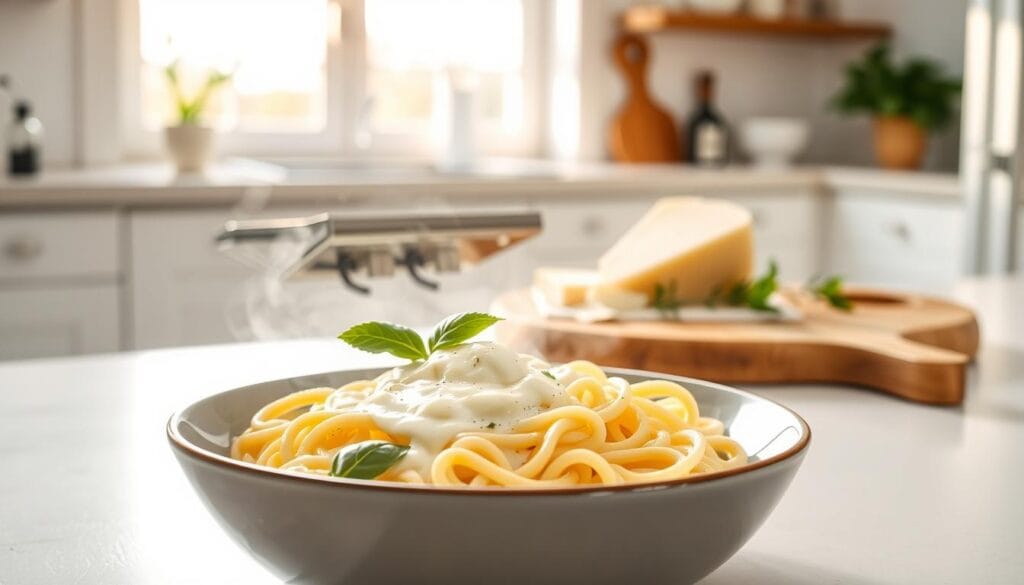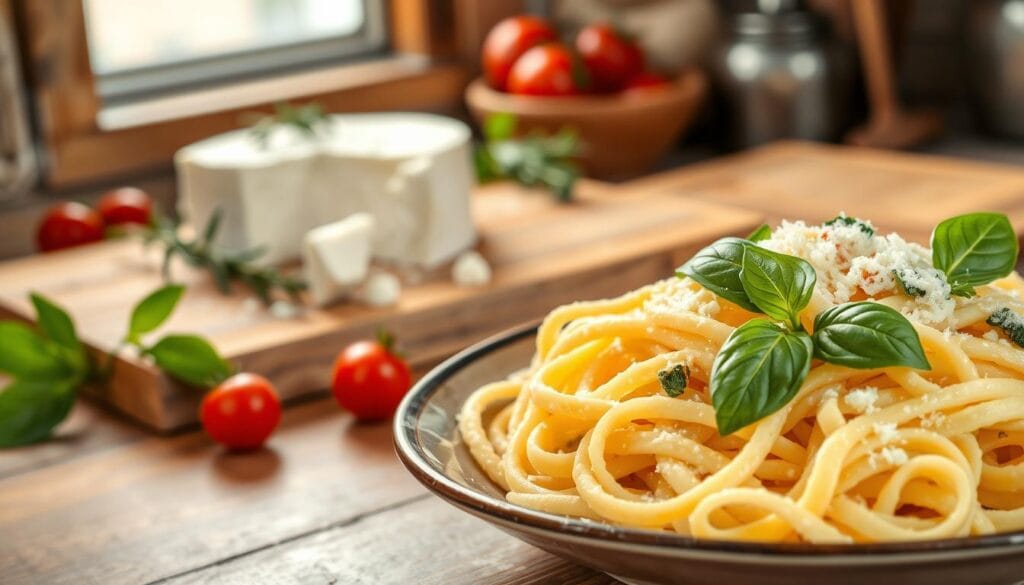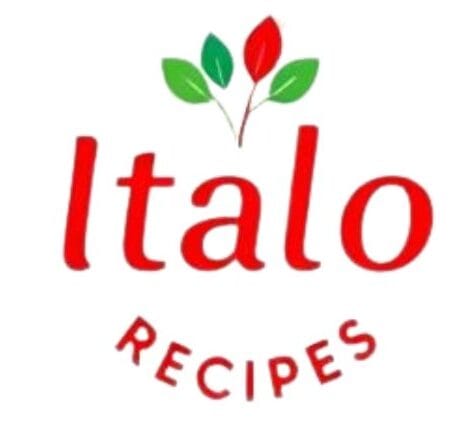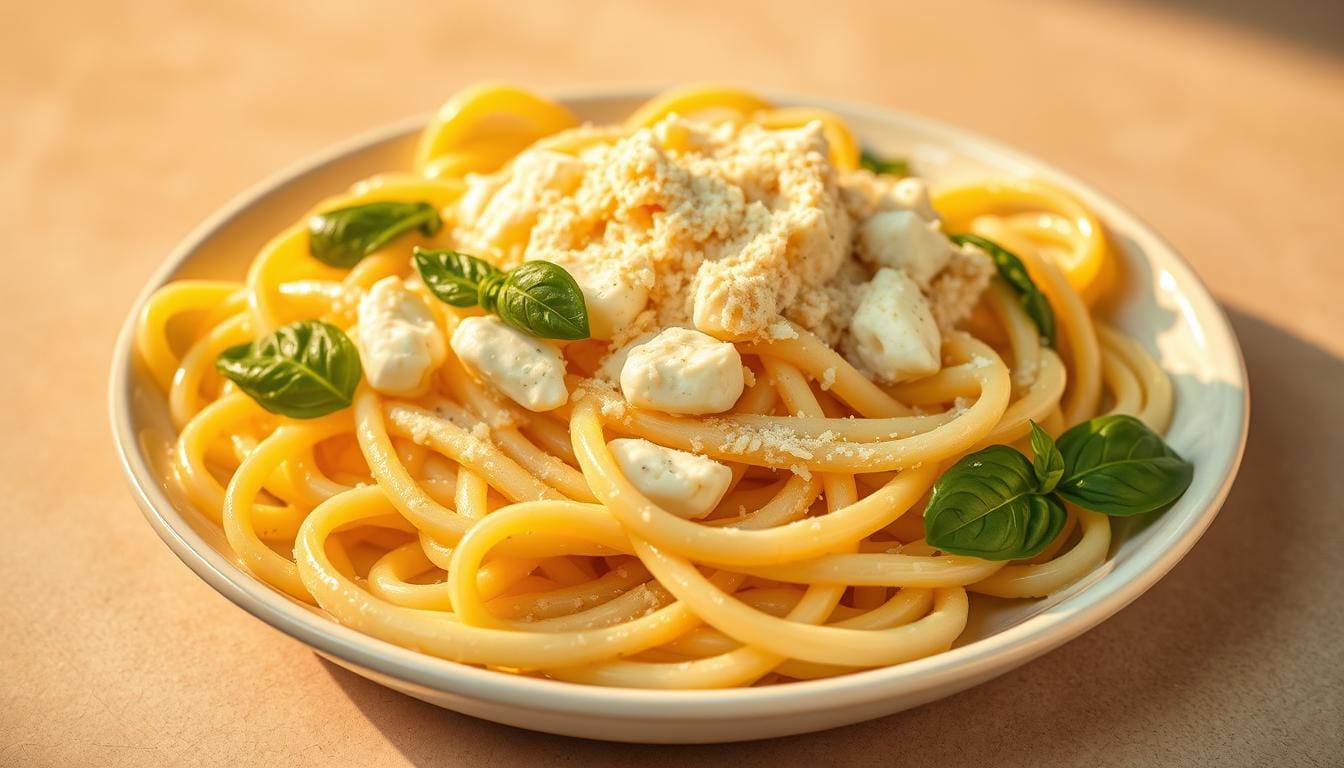Pasta e Ricotta: Italian Tradition & Must-Try Recipes
Imagine being in Italy, surrounded by the smells of traditional food. Italian ricotta pasta shows the beauty of simple, elegant Italian cooking.
Bring this Italian delight home with ricotta pasta recipes. Pasta, ricotta, and other ingredients blend perfectly. This mix of flavors will impress anyone.
Table of Contents
Key Takeaways
- Discover the significance of pasta e ricotta in Italian cuisine.
- Explore various ricotta pasta recipes to try at home.
- Learn about the key ingredients and cooking techniques involved.
- Understand the versatility of ricotta in different pasta dishes.
- Get inspired to create your own Italian culinary masterpieces.
The Origins of Pasta e Ricotta
The mix of pasta and ricotta in Italian cooking is more than just taste. It shows the country’s rich culinary history. You might wonder how this dish became so loved. Let’s look into its historical and cultural roots.
A Brief History of Italian Pasta
Italian pasta has a long history, starting in the Middle Ages. The word « pasta » means « dough » in Italian. It has been a key part of Italian food for ages.
The ancient Italians ate something called « lagana, » an early version of lasagna. As time went on, pasta grew in popularity across Italy. Each region developed its own pasta shapes and recipes.
The Role of Ricotta in Italian Cuisine
Ricotta cheese is crucial in Italian cooking, especially in pasta e ricotta. It’s interesting to know ricotta is used in many Italian dishes, from savory to sweet. Its creamy texture and mild taste make it very versatile.
In pasta e ricotta, ricotta adds a special richness. This makes the dish even more enjoyable. Enjoying pasta e ricotta means you’re part of a long-standing culinary tradition.
Essential Ingredients for Pasta e Ricotta
The secret to a delicious Pasta e Ricotta lies in the ingredients. The quality of pasta and ricotta greatly affects the taste and texture.
Choosing the Right Pasta Type
Choosing the right pasta is key for Pasta e Ricotta. Choose pasta shapes that hold creamy sauces well, like pappardelle, fusilli, or rigatoni. These shapes ensure every bite is covered in the creamy ricotta.
For an easy ricotta pasta dish, use fresh, high-quality pasta. Fresh pasta has a better texture and absorbs flavors well. But, if making homemade ricotta pasta, make sure it’s not too thin to avoid mushiness.
Selecting High-Quality Ricotta
Ricotta is the heart of Pasta e Ricotta. Choose ricotta that is smooth and creamy for the best texture in your creamy ricotta pasta. You can buy it or make it at home.
Making your ricotta at home gives you control over quality and freshness. To get a creamy texture, drain the ricotta well. As Julia Child said,
« The only time to eat diet food is while you’re waiting for the steak to cook. »
In Pasta e Ricotta, this means enjoying high-quality, creamy ricotta.
Classic Pasta e Ricotta Recipe

Try making pasta e ricotta at home for a real Italian taste. It’s easy to make and tastes amazing. It’s sure to become a favorite dish for you.
Step-by-Step Cooking Instructions
First, cook your pasta until it’s al dente, as the package says. While it cooks, heat some olive oil in a pan. Add minced garlic and cook until it smells good, but don’t let it burn.
Then, mix in your ricotta cheese with a bit of salt and black pepper. If it’s too thick, add some pasta water. Once your pasta is done, drain it and mix it with the ricotta. Toss until the pasta is well coated.
Tips for Perfecting Your Dish
To make your pasta e ricotta even better, sprinkle some Parmesan cheese on top. Fresh herbs like parsley or basil also add great taste and look.
Remember, don’t overcook your pasta. Al dente pasta works best with the ricotta sauce. It makes every bite creamy and delicious.
Variations of Pasta e Ricotta
There are many ways to make pasta e ricotta, from traditional to modern. This Italian dish is very flexible. You can try different ingredients and flavors.
Regional Twists on the Classic Dish
In Italy, each region has its own pasta e ricotta style. Some add spinach or other greens to the ricotta for extra nutrition. Others use local ingredients like truffles or prosciutto for unique tastes.
Vegetarian and Vegan Alternatives
Vegetarians and vegans have options too. You can use cashew or tofu ricotta for a vegan version. Also, try different pasta sauces like tomato or olive oil and garlic for a fresh twist.
Exploring these variations lets you enjoy pasta e ricotta in new ways. You can make it fit your diet and cooking style.
Pairing Suggestions for Pasta e Ricotta
Enjoying pasta e ricotta is even better with the right pairing. The creamy texture and rich flavors of this Italian dish pair well with various wines and side dishes.
Let’s look at the best wines to go with creamy ricotta pasta. A crisp white wine, like Pinot Grigio or Sauvignon Blanc, balances the richness of the ricotta.
Ideal Wine Choices
Here are some top wines for pasta e ricotta:
- Pinot Grigio: A crisp and refreshing white wine that complements the delicate flavors of ricotta.
- Sauvignon Blanc: A citrusy and herbaceous wine that pairs well with the bright, creamy texture of ricotta.
- Dolcetto: A light-bodied red wine with moderate acidity that can complement the earthy flavors in some pasta dishes.
Complementary Side Dishes
Side dishes can also make your meal better. Try these with your pasta e ricotta:
- Roasted vegetables: Grilled or roasted vegetables, such as asparagus or Brussels sprouts, add a nice contrast.
- Garlic bread: A classic Italian staple that goes well with the rich flavors of pasta e ricotta.
- Green salad: A simple green salad with a light vinaigrette can help cut the richness of the dish.
Pairing your pasta e ricotta with the right wine and side dishes makes for a great meal.
Health Benefits of Pasta e Ricotta

You might be surprised to learn that pasta e ricotta can be a nutritious addition to your meal plan. Pasta is often misunderstood, but it can be part of a balanced diet. This is especially true when paired with nutrient-rich ingredients like ricotta cheese.
Ricotta cheese is an excellent source of protein, calcium, and various vitamins and minerals. It’s also relatively low in calories compared to other cheeses. Using high-quality, homemade ricotta in your ricotta pasta recipe boosts the nutritional value and flavor of your dish.
Nutritional Value of Ricotta Cheese
Ricotta cheese is rich in several key nutrients, including:
- Protein: Essential for muscle repair and growth
- Calcium: Crucial for bone health
- Vitamin B12: Important for energy production and nerve function
- Phosphorus: Supports bone health and kidney function
By incorporating ricotta into your pasta dishes, you’re adding a nutritious element. This complements the carbohydrates in the pasta, creating a healthy meal balance.
Balancing Pasta in Your Diet
To make your homemade ricotta pasta a healthy choice, consider these tips:
- Choose whole-grain or whole-wheat pasta for added fiber
- Pair your pasta with plenty of vegetables for extra nutrients
- Use ricotta cheese in moderation as part of a balanced sauce
- Experiment with herbs and spices to add flavor without extra salt or sugar
By making a few simple adjustments to your ricotta pasta recipe, you can enjoy a delicious and nutritious meal. This meal fits into your healthy eating plan.
By being mindful of your ingredients and portion sizes, you can indulge in the rich flavors of pasta e ricotta. You can do this while maintaining a balanced diet.
Making Pasta from Scratch
Making pasta from scratch is a simple yet rewarding process. It lets you create delicious ricotta pasta dishes.
To start, you’ll need a few basic pieces of equipment. The right tools make the process smoother and more enjoyable.
Equipment You Need at Home
- A large mixing bowl for combining ingredients
- A wooden spoon or stand mixer for mixing the dough
- A clean surface for kneading
- A rolling pin for flattening the dough
- A pasta machine or sharp knife for cutting the pasta
Investing in a pasta machine is beneficial if you make pasta often. But, a sharp knife works for occasional use.
Beginner-Friendly Dough Recipes
A basic pasta dough recipe includes flour, eggs, and salt. Here’s a simple recipe to get you started:
- 2 cups of all-purpose flour
- 2 eggs
- 1 teaspoon of salt
Combine the flour and salt in a mixing bowl. Make a well in the center and crack in the eggs. Mix until a dough forms, then knead for about 10 minutes until the dough is smooth and elastic.
Once your dough is ready, you can roll it out and cut it into your desired pasta shape. Whether you’re making easy ricotta pasta or another variety, the freshness of homemade pasta will elevate your dish.
With your pasta made, you can now enjoy it with ricotta and your choice of additional ingredients. This will give you a truly delicious ricotta pasta experience.
Famous Italian Chefs’ Takes on Pasta e Ricotta
Italian chefs have made their mark on pasta e ricotta. They’ve brought new life to this classic dish with their unique touches.
Insights from Renowned Chefs
Chefs like Massimo Bottura and Giorgio Locatelli have put their own spin on pasta e ricotta. They’ve used new techniques and ingredients to make it stand out.
Massimo Bottura suggests adding truffle to the ricotta for extra flavor. « The key to a great pasta e ricotta is in the quality of the ricotta, » he says. Giorgio Locatelli recommends using high-quality, fresh pasta to take the dish to the next level.
Alessandro Borghese adds a modern twist by mixing saffron into the pasta dough. This gives the pasta a unique taste and color. These chefs show how old recipes can be made new again.
Modern Takes on Tradition
Modern pasta e ricotta recipes often mix things up with new ingredients and methods. For example, using different cheeses or adding special herbs can change the taste.
| Chef | Modern Twist | Key Ingredient |
|---|---|---|
| Massimo Bottura | Truffle-infused ricotta | Truffle |
| Giorgio Locatelli | Fresh, handmade pasta | Fresh pasta |
| Alessandro Borghese | Saffron-infused pasta dough | Saffron |
Hosting a Pasta e Ricotta Dinner Party
Creating a memorable dinner party is more than just serving food. To host a great pasta e ricotta dinner, think about the ambiance and menu. Start by planning a menu that goes well with your creamy ricotta pasta.
Menu Ideas for an Italian Feast
Start with antipasti like bruschetta or caprese salad. Then, serve your pasta e ricotta as the main dish. Don’t forget to add Italian desserts like tiramisù or cannoli. Pair your meal with wine, such as Pinot Grigio or Chianti, for a full Italian experience.
Setting the Mood
To create an authentic Italian vibe, decorate with warm lighting and vintage posters. Add rustic wooden accents and play traditional Italian music. With these touches, you’ll host a memorable pasta e ricotta dinner party that guests will love.

